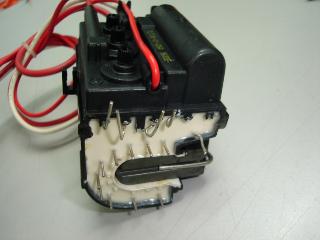Understanding Flyback Transformer Pinout The Easy Way
Television and monitor flyback transformer pinout have some common designed except that the monitor flyback have internal capacitor built in. The internal capacitor value have around 2.7 nanofarad to 4.5 nanofarad to improve the picture quality especially when the monitor that can go for a higher resolution compare to Tv. If without the internal capacitor in the monitor flyback the display will curve or slightly out of shape especially at both the right and left hand side of the picture.
Mostly tv and monitor flyback transformers have about ten pins at the bottom of the flyback. Each of the pin have a purpose or function as part of a complete circuit. The common pins that you can find in monitor flyback are: B+ pin, Horizontal collector pulse, ABL (automatic blanking limiter), GROUND, G1, AFC (automatic frequency control), VCC, HEATER (to filament) and X-RAY protection.
The B+ and horizontal collector pulse pin forms one winding which we call it as flyback primary winding. It can only can be test by using a flyback meter such as the Dick Smith Lopt tester  or sencore LC102 and LC103C.Normal meters can't check this kind of fault. This is the most important winding compares to others and it can easily developed a short circuit when B+ voltage line or Horizontal output transistor (HOT) shorted. Sometimes a shorted internal capacitor in the flyback transformer may cause the primary winding to burn internally and the flyback became bulge and poured out the epoxy.
or sencore LC102 and LC103C.Normal meters can't check this kind of fault. This is the most important winding compares to others and it can easily developed a short circuit when B+ voltage line or Horizontal output transistor (HOT) shorted. Sometimes a shorted internal capacitor in the flyback transformer may cause the primary winding to burn internally and the flyback became bulge and poured out the epoxy.
Other pins are the ground, G1, and AFC winding. AFC stand for automatic frequency control and it send signal (pulse) from the flyback transformer to the horizontal oscillator ic to lock or synchronize the frequency of the monitor. If this AFC line fails the picture will shift either to the far left or far right. There is no way that you can adjust the picture to the center even with the internal adjustment in the mainboard. The purpose of G1 voltage is to pull the electron generated from the cathode (after the heater or filament heat up) and passed it to G2 which is the screen voltage.
G1 normally is a negative voltage. Most tv picture tube do not use G1 voltage. If the G1 voltage is missing or zero voltage to the picture tube the monitor display will becomes very bright with retrace lines (diagonal lines or flyback lines) across the screen and sometimes the monitor will goes into shutdown mode.
ABL stand for automatic blanking limiter- I refer it as a contrast circuit. Why? because whenever there is a contrast problem i will search for this pin and begin to trace from there. Normally a resistor increased in resistance and a shorted ceramic capacitor caused the display to become dim and you may think it might be the fault of a bad CRT.
Heater or filament pin nowadays hardly found in monitor flyback because the crt heater voltage now is derived directly from the switch mode power supply. However heater pin is still can be found in television flyback transformer. If the anode voltage is too high (more than 30 kilovolt), the x-ray protect pin will send a signal to horizontal oscillator ic in order to disable the horizontal drive waveform.
Without the horizontal drive pulse the high voltage generated by the flyback will collapsed and protect the user from excessive x-ray.
The flyback transformer pinout will also generate high pulse ac which later convert to dc through an ultra fast recovery diode. For your information, the ac pulse generated by the flyback transformer cannot be check with our normal analog or digital meter. the frequency is so high and you need a special meter to do the job. The dc voltages are then supply to various circuit such as the vertical output circuit. If you understand all the functions of each flyback transformer pinout, repairing monitor or tv will be much easier and save your precious time.
If you want to know more details about tv and monitor flyback transformer ,you may visit HRDIEMEN website and buy one of those CD that they offered. A little amount of investment can change the whole concept on how you look at a flyback transformer especially the pinout.
source:Electronicrepairguide.com
No comments:
Post a Comment